RBA Annual Conference – 2011 Australia's Prosperous 2000s: Housing and the Mining Boom Jonathan Kearns and Philip Lowe[*]
1. Introduction
At the start of the 2000s Australia was derided by some for being an ‘old economy’. It lacked a substantial information and communications technology sector and was seen to be overly dependent on the extraction of resources, an activity that was not going to be enriching due to the declining relative value of commodities and weak potential productivity gains. However, by the end of the 2000s Australia was once again seen as the Lucky Country, riding on the back of rapidly rising commodity prices and having experienced only mild downturns at the time of the two international recessions that bookended the decade.[1] Overall, it was indeed another prosperous decade; the unemployment rate fell and incomes rose strongly. The 2000s was the first decade since Federation in which the annual growth rate of real GDP in Australia remained positive throughout the decade.
The 2000s will be remembered for the mining boom and closer trade links to China. In 2000, Australia had a growing economic relationship with Asia, but most eyes were still focused elsewhere, particularly on the United States. For example, in the volume from the Reserve Bank's Conference in 2000 reviewing the 1990s (Gruen and Shrestha 2000), the words ‘China’ and ‘Chinese’ do not appear, but the ‘United States’ is mentioned 93 times. The focus has now changed dramatically, with significantly increased attention paid to the extent to which Australia's economic fortune is tied to that of Asia. The most visible manifestation of the increasing development of Asia was the surge in commodity prices and the terms of trade; in SDR terms the average level of the Reserve Bank's commodity price index at the end of the decade was almost two and a half times its average in 1999.[2] This increase led to a significant policy debate about how to deal with the boom in the terms of trade, both regarding what to do with the increased government revenue and how to accommodate the resulting structural change in the economy.
While the commodity boom and the global financial crisis were dominant themes over the second half of the decade, in the first half it was strong growth in household spending and substantial increases in household borrowing and house prices that dominated the discussion. Despite household spending having since moderated, there have been lasting effects on the household sector's balance sheet. A related major policy debate of the decade concerned the causes and consequences of this housing boom.
A third theme of the decade surrounded developments in the labour market. At the start of the decade the unemployment rate was around 6½ per cent. Gruen and Stevens (2000) noted that stable growth and a long expansion meant that maintaining the unemployment rate below 6 per cent seemed ‘only slightly ambitious’ whereas earlier in the 1990s it would have ‘seemed ludicrous to many’. In the end, the unemployment rate was below 6 per cent for two-thirds of the 2000s, and reached a trough of 4 per cent, a rate not seen since the mid 1970s. This impressive performance raised an important question: below what rate of unemployment would inflation accelerate? In the quest to enhance the functioning of the labour market there were substantial debates regarding the form of regulations that would achieve the best employment and social outcomes. This issue is considered in detail in Borland (this volume) and so is not pursued further here.
Over the decade, growth in employment was strong relative to that in output, with labour productivity growth slowing markedly from the rates in the 1990s. The capital stock also grew more rapidly in the 2000s than in the 1990s, so that the slowdown in multifactor productivity was more pronounced. The issue of weak productivity growth periodically surfaced, but was to some extent hidden by reasonable growth in output as a result of greater factor usage and by a boost to real incomes from the rise in the terms of trade. These trends are discussed in more detail by Eslake (this volume).
In this paper we provide an overview of the Australian economy in the 2000s. The paper begins with a comparison of the performance of the Australian economy in the 2000s to that in previous decades. Sections 3 and 4 then consider the implications of the two driving forces for the two halves of the decade: the changes to household balance sheets and the impact on Australia of rapid development in Asia. Sections 5 and 6 discuss the major debates regarding monetary and fiscal policy. While the role of policy has generally been less topical in the 2000s than was the case in the 1990s, there were nonetheless active debates regarding the role of asset prices in monetary policy settings, and how fiscal policy should respond to a rising terms of trade. Finally, in Section 7 the paper considers how Australia might best take advantage of the new opportunities offered by the transformation of the global economy, while at the same time managing the risks that come with this transformation.
2. Overview of the Decade
Despite the perception of being an old economy, Australia was experiencing above-average growth at the turn of the century, with strong domestic demand and stimulus provided by a strong international economy and a low exchange rate (Figure 1). The announced introduction of the Goods and Services Tax (GST) on 1 July 2000 resulted in a substantial bring-forward in housing investment which saw a slowing in the second half of the year. Just as the economy was recovering, the international economy was slowing, with the United States and a few other developed economies entering a shallow recession (see Bayoumi and Bui in this volume for a summary of the North Atlantic economies over the decade). It had often been said that when the United States sneezes, Australia catches a cold. But on this occasion, the Australian economy did not follow the United States into recession. There are a number of reasons for this. The first is that, thanks to fortuitous timing, the Australian economy was bouncing back from the slowing in the second half of 2000 associated with the introduction of the GST. Second, in a signal of the changing economic landscape, Australia's major trading partner growth remained positive thanks to strong growth in Asia and despite output in the G7 declining in three consecutive quarters. Third, the bursting of the tech bubble did not lead to large negative wealth effects in Australia as the absence of large tech firms meant that the domestic equity market continued to rise through to 2002 as global markets declined. Finally, reinforcing these effects, household spending remained strong as house prices and household wealth continued to rise. As the Australian economy outperformed other developed economies in the early part of the decade, the Australian dollar rebounded from its all-time low in 2001 to around the average of the floating era by 2003.
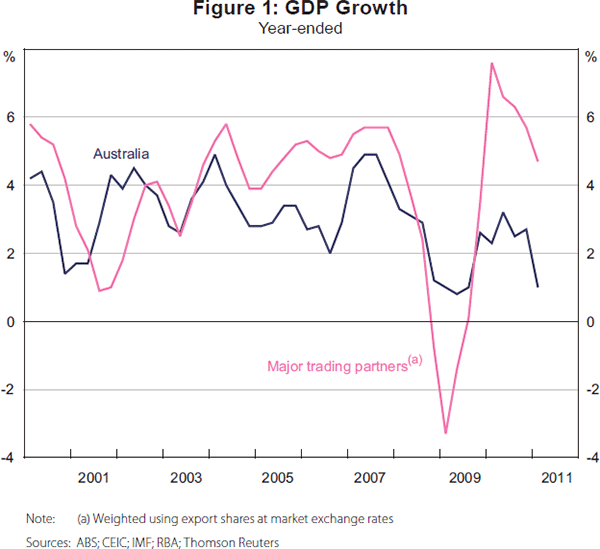
Consumer spending in Australia continued to grow at a brisk rate following the global downturn, fuelled by rising incomes and wealth. The robust growth in domestic demand was to a large extent self-reinforcing, as strong employment growth and rising wages drove income growth, which in turn contributed to rapid house price growth. The increasing value of housing assets, and solid stock market returns, meant that household wealth grew at an above-average rate. Consequently, households felt more confident and were willing to take on more debt and reduce their saving. The impact on household balance sheets of rapid house price growth and the associated increase in debt was substantial, as discussed further in Section 4. Concern that speculative elements were building given the rapid price growth and expansion of credit, and the possibility of the erosion of lending standards, led to a number of policy initiatives, as outlined in Section 5 (see also Bloxham, Kent and Robson (2010)). While domestic demand was strong, export growth was weaker than might have been expected given above-average growth in Australia's major trading partners, and consequently the trade deficit and current account deficit remained wide.
In late 2003 the seemingly inexorable rise in house prices finally abated with national dwelling prices flat in nominal terms over the following couple of years; prices fell in Sydney, with small price rises in most other cities. Nevertheless, households remained optimistic, with consumption broadly growing in line with incomes and the net household saving ratio remaining around zero. Gradually, though, business investment came to play a more important role as a driver of growth in the middle part of the decade. Initially the strength in investment was in the non-mining economy, but with the sharp increase in commodity prices from 2005, mining investment increased dramatically (as discussed by Connolly and Orsmond in this volume). With this shift from consumption to investment, domestic demand continued to be the main source of growth for the Australian economy as export growth remained below expectations. Resource volumes were unable to respond immediately to the stronger global demand, and the further appreciation of the Australian dollar associated with the rise in commodity prices weighed on other exports and stimulated import demand.
Through this sustained expansion in the middle of the decade, excess capacity was gradually absorbed with the unemployment rate declining by 3 percentage points from late 2001 and survey measures of capacity utilisation reaching record highs. With inflationary pressures building, monetary policy was gradually tightened over a long six-year phase. The cash rate reached 7.25 per cent in early 2008, its highest level in over a decade.
The domestic economy was slowing over the first half of 2008, prior to the extreme financial shock in September in the aftermath of the bankruptcy of Lehman Brothers. The resulting collapse in sentiment and the marked deterioration in the global economic outlook precipitated a sharp fall in commodity prices and the Australian dollar and a prompt fiscal and monetary stimulus in Australia. By May 2009, the RBA's commodity price index in SDRs had fallen by over 30 per cent from its October 2008 level, while the Australian dollar depreciated by around 30 per cent over the six months from its July 2008 peak. The first stage of a large discretionary fiscal stimulus – which totalled around 6 per cent of GDP over several packages – was implemented within three months of the collapse of Lehman Brothers. Monetary policy was also eased rapidly, with the cash rate cut by 100 basis points at the scheduled Reserve Bank board meeting just three weeks after the collapse of Lehman Brothers, and by a total of 375 basis points within five months of the Lehman Brothers collapse. The downturn in Australia turned out to be milder than expected, thanks to the rapid policy response, the sharp depreciation of the Australian dollar and the strong demand for bulk commodities from China, which resulted in part from infrastructure construction associated with China's own large fiscal stimulus. As a result of China's demand, Australian export volumes continued to grow through late 2008 and early 2009, a remarkable performance given global trade volumes fell by around 20 per cent.[3] Despite the deep recessions in developed economies, key emerging economies continued to grow and demand for Australian export commodities rebounded quickly with SDR prices exceeding their previous peak a little over 18 months after their precipitous decline.
The Australian dollar quickly appreciated along with rising commodity prices. Apart from the large, but short-lived, fall during the financial crisis, the currency trended higher over the 2000s with the trade-weighted exchange rate appreciating more than 40 per cent in nominal terms from its trough in 2001 to the end of the decade, and almost 60 per cent on a real basis (Figure 2). By the end of the decade, the real effective exchange rate was at its highest level since 1977.
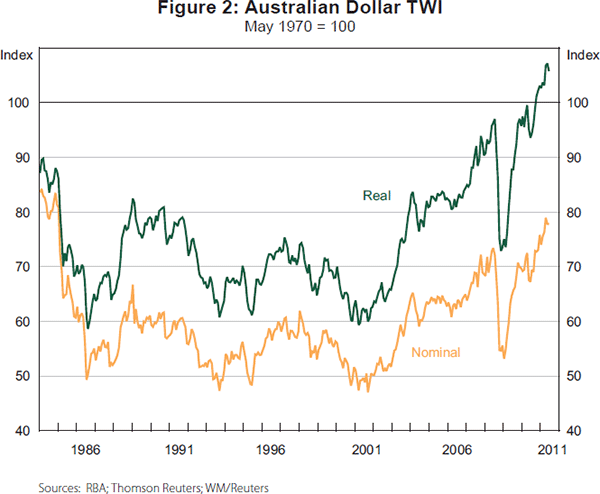
A recurring theme in the second half of the decade was that the economy was operating at multiple speeds, with rapid growth in mining and related sectors, and below-trend growth in a number of other sectors and in the south-eastern states. This often led to the claim that monetary policy settings were inappropriately tight for the non-mining parts of the economy. This mirrored the argument earlier in the decade that the setting of monetary policy was overly tight because of the housing boom in the south-eastern states. While there were differences in regional and sectoral economic performance, on the whole there was substantial spillover from the mining sector to other parts of the economy through demand for goods and services by the mining sector, taxes and income flows to other sectors through dividend payments, as discussed in Connolly and Orsmond (this volume) and Stevens (2010a, 2011).
2.1 The 2000s in historical context
On many levels the 2000s were a successful decade for Australia. As discussed above, Australia experienced relatively mild downturns in the face of two international recessions, and in between these experienced a strong expansion. Annual employment growth averaged 2.2 per cent over the decade, substantially faster than in the 1990s and recovering to rates recorded in the 1960s and 1980s (Table 1). In both downturns experienced in Australia, the increase in the unemployment rate was much smaller than in the 1980s and 1990s recessions, and subsequently fell more quickly. Consequently, the average unemployment rate over the decade was significantly lower than in the 1980s and 1990s and, in addition, there was a substantial increase in the participation rate. Indeed, the low unemployment rate in the second half of the decade – which troughed at 4 per cent, a rate not seen since the mid 1970s – prompted significant consideration as to what rate represented full employment (see Borland in this volume).
| 1960s | 1970s | 1980s | 1990s | 2000s | |
|---|---|---|---|---|---|
| Real GDP growth | 5.1 | 3.1 | 3.4 | 3.4 | 3.0 |
| Real GDP per capita growth | 3.0 | 1.5 | 1.8 | 2.2 | 1.5 |
| Employment growth(a) | 2.5 | 1.6 | 2.4 | 1.2 | 2.2 |
| Unemployment rate | 2.0 | 3.9 | 7.6 | 8.8 | 5.5 |
| CPI inflation (excl interest)(a) | 2.5 | 10.1 | 8.1 | 2.8 | 3.2 |
| CPI inflation (excl interest and GST impact)(a) | 2.5 | 10.1 | 8.1 | 2.8 | 2.8 |
| Balance of trade (per cent of GDP) | −1.1 | 0.0 | −1.9 | −0.8 | −1.3 |
| Current account (per cent of GDP) | −1.8 | −1.1 | −4.1 | −4.0 | −4.6 |
|
Note: (a) Annualised rate Sources: ABS; RBA |
|||||
The introduction of the GST at the start of the decade added a little over 3 percentage points to the headline inflation rate. As this was a temporary impact, the Reserve Bank said at the time it would not react to this spike in inflation. Abstracting from this, annual inflation over the decade averaged 2.8 per cent, consistent with the inflation target that inflation should average ‘two-point-something’, although slightly higher than the 1990s inflation-targeting period.[4]
For much of the 2000s, growth in export volumes was surprisingly weak given generally strong external conditions, the low value of the exchange rate over the first part of the decade and the strong commodity demand over the latter part of the decade. Conversely, the growth in consumption and investment resulted in strong import growth. Consequently, the average trade deficit, at 1.3 per cent of GDP, was larger than in the 1990s, but still smaller than in the 1980s. Toward the end of the decade the trade position moved to surplus, as a result of the increased value of resource exports. The average current account deficit in the 2000s was larger than in previous decades at 4.6 per cent of GDP, reflecting the trade deficit as well as increased net foreign liabilities and strong returns on Australian assets. Equivalently, the large current account deficit in Australia can be seen as the outcome of the high investment rate. This was Australia's largest decade average current account deficit in the period since Federation. Yet the 1980s debate about the perils of current account deficits summarised in Tease (1990) did not resurface, with a general view that the current account deficit in Australia did not represent an imbalance, but rather the outcome of savings and investment decisions of individuals and firms in the absence of major distortions, as discussed in Debelle (2011).
One area in which Australia's performance over the 2000s was less impressive is the growth of output per capita. While average real GDP growth, at 3 per cent, was roughly ½ percentage point less than in the 1980s and 1990s, growth in real GDP per capita was ¾ percentage point less than in the 1990s reflecting the stronger population growth in the 2000s (Figure 3). Further, much of this growth in per capita GDP reflected greater use of factors of production: labour utilisation increased with the decline in the unemployment rate and the increase in the participation rate, while the pick-up in investment resulted in faster growth in the capital stock (Figure 4). The relatively weak growth in output given the stronger growth in labour and capital reflects the marked slowing in multifactor productivity growth in the 2000s. In contrast, productivity growth, and so growth of GDP per capita, had accelerated in the 1990s following significant economic reforms.
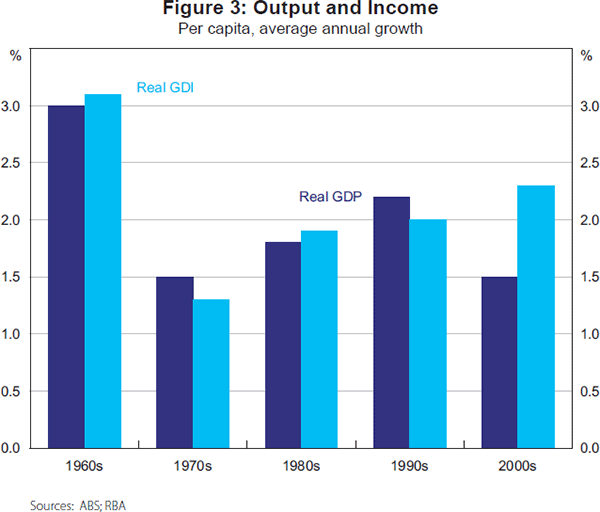
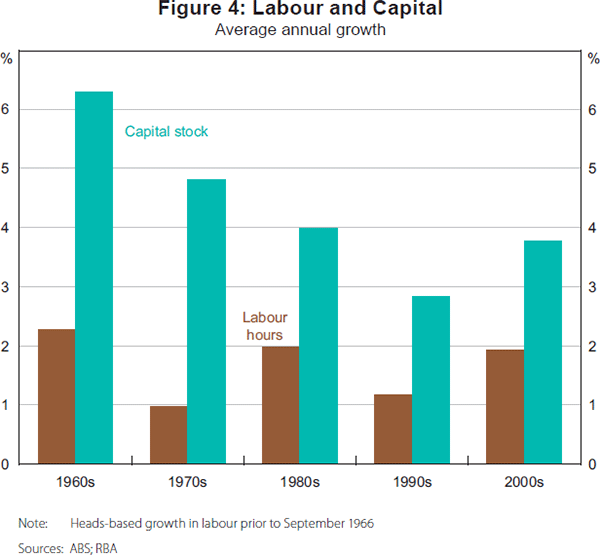
While growth in productivity and GDP per capita were weak in the 2000s, this was offset by the large increase in the terms of trade, which resulted in faster real income growth. Real gross domestic income (GDI) per capita grew at an average annual rate of 2.3 per cent, the fastest rate since the 1960s, and well above the 1.5 per cent average growth in per capita real GDP. Since this margin between GDP and GDI growth reflected the increase in the terms of trade from higher commodity prices, and the mining sector has significant foreign ownership, some of this income growth will have accrued to foreigners (see Connolly and Orsmond in this volume).
3. Development in Asia – Implications for Australia
Australia has greatly benefited from the rapid growth in Asia over the past decade, in particular in China and India. As Huang and Wang (this volume) summarise, the development of Asia has been quite remarkable. Not only did Asian countries experience fast growth in the 2000s, but for China and India this growth was uninterrupted in contrast to the major developed economies. As a result, Asia's share (excluding Japan) of world GDP, at market exchange rates, has increased from around 10 per cent in 2000 to 17 per cent in 2010. Australia has prospered from this growth, both because of its endowment of natural resources and because growth in Asia means that there are now large economies closer to Australia than has previously been the case.
Industrialisation and urbanisation in China, and elsewhere in Asia, has greatly increased demand for resources, especially coal and iron ore for producing steel. China alone now accounts for almost half of global steel production. Australia is a major exporter of the key resources for steel production because it has large endowments of coal and iron ore, relative to a comparatively small population. In 2010, iron ore accounted for 17 per cent of the value of Australia's exports, while coal accounted for another 15 per cent. This represented incredible growth, rising from 3 and 7 per cent of export values, respectively, in 2003. Other exporters of these bulk commodities, such as Brazil for iron ore, have also benefited from this strong demand and the associated rising prices. However, being closer to China with direct shipping access has been an additional benefit for Australian producers as it lowers the cost of shipping. This boosts demand for Australian bulk commodities or increases the revenue of Australian producers, and so benefits Australian producers in the same way as having lower extraction costs.
The increase in commodity prices, and in particular coal and iron ore prices, has led to substantial efforts to increase commodity production. Since 2005, mining investment has increased from 12½ per cent of total private business investment to be around one-quarter. As a share of GDP, mining investment has increased from less than 2 per cent to around 4 per cent now, and with a significant contribution from liquefied natural gas (LNG) is forecast to increase to be above 6 per cent in coming years. Mining is more capital intensive than other industries and so, with a bigger mining sector, Australia's capital-output and investment-output ratios have increased and are likely to remain higher than they have been.
The increase in the size of the mining sector is likely to make the Australian economy, and its fiscal position, more cyclical. Commodity prices are inherently more volatile than prices of services or manufactured goods because supply is typically less elastic in the short run and demand more sensitive to economic cycles. In addition, historically, the difficulty in forecasting commodity demand and prices, particularly at the long horizons of resource investment projects, has often led to over-investment and ‘hog cycles’.
The mining boom has had other implications for the structure of the Australian economy. As well as mining investment and construction, it has increased the demand for labour, although overall mining-related employment remains a very small share of total employment. The flexibility of the Australian labour market has thus far enabled this greater demand to be accommodated without significant labour shortages or widespread increases in wages. The increase in commodity prices has also seen the Australian dollar appreciate significantly to 30-year highs in real terms, contributing to the reallocation of resources within the economy.
The growth of Asian economies has also lessened the isolation of Australia from major economic markets. Quah (2011) documents how the centre of global economic activity has shifted from being in the mid Atlantic in 1980, to be east of Bucharest in 2008, and is projected to be between China and India by 2050. Australia is still not close in absolute distance to large economies; for example, Beijing and Delhi are both closer to London than they are to Sydney. However, it certainly is the case that Australia is closer to Asia than it is to Europe or the United States. So the expansion of the Asian economies reduces Australia's relative economic isolation. This should work to increase Australia's trade, as distance is significant in explaining a country's trade; see, for example, Guttman and Richards (2006) and Disdier and Head (2008). Despite this, while the ratio of Australia's imports and exports to GDP increased in the 1990s following tariff reductions, it has been relatively stable through the 2000s despite the rapid growth of Asian economies.
The benefits of this relative proximity to large economies in Asia are likely to be more evident in some non-resource sectors, particularly services such as tourism and education. Education has been one of Australia's strongest growing export sectors; being relatively close, in a similar time zone with well-established English-language courses and generally favourable visa arrangements is an advantage. Australia is one of the five largest education exporters in the OECD and much of this demand has come from China and India. China and India together now account for just over 40 per cent of Australian education exports versus around 15 per cent at the start of the decade. But growth in education exports is likely to slow because of increased competition internationally, the appreciation of the Australian dollar, more restrictive visa requirements and some domestic capacity constraints (Hall and Hooper 2008).
Similarly, the share of tourism from China and Hong Kong is roughly double what it was in 2000; with a combined share of around 11 per cent they represent the second largest source of tourist arrivals. Nevertheless, this is still only half of the share coming from other countries in Asia, even after excluding Japan. But while rising incomes in Asia have increased tourist numbers, macroeconomic and other factors still have a dominant impact on tourism. The rising Australian dollar over the decade has depressed inbound international tourist numbers – as did the terrorist attacks in September 2001, the outbreak of SARS, and the financial crisis – so that overall growth in this sector has been weak.
The effects of developments in Asia flow through Australian imports as well as exports. Urbanisation and industrialisation has greatly expanded the production of manufactures in non-Japan Asia. As a result, the share of global manufactures trade coming from Asia, and China in particular, has greatly increased over the past decade. The heightened competition from Asian manufacturers exerted significant downward pressure on global manufactures prices. Consequently Australian import price growth was low over the decade, which also worked to boost the terms of trade. Overall, imports from Asia have increased from around 40 per cent of total imports at the start of the decade to around one-half.
There are some similarities in the impact on Australia from the development of China over the past decade and the growth of Japan in the mid 1960s to mid 1970s. Japan was already a significant trading partner accounting for 17 per cent of Australia's merchandise exports in 1965. With continued rapid growth over the following decade, Japan's demand for resources from Australia increased substantially. The share of Australian exports going to Japan doubled to 34 per cent and the resource share of Australian exports trebled to just under 40 per cent (Figure 5). This increase in Australia's resource exports and the importance of an individual trading partner looks remarkably similar to the 2000s. However, an important difference is that over the period from 1965 to 1975 Australia's terms of trade did not increase as they have recently (Figure 6). The increase in Australia's resource exports to Japan resulted from rapid growth in the volume of resource exports, with resource prices moving broadly in line with import prices. In part, the rapid growth in volumes reflected the discovery and development of large iron ore deposits. In contrast, over the past decade the increase in the share of resource exports is attributable to a substantial increase in prices, not volumes.
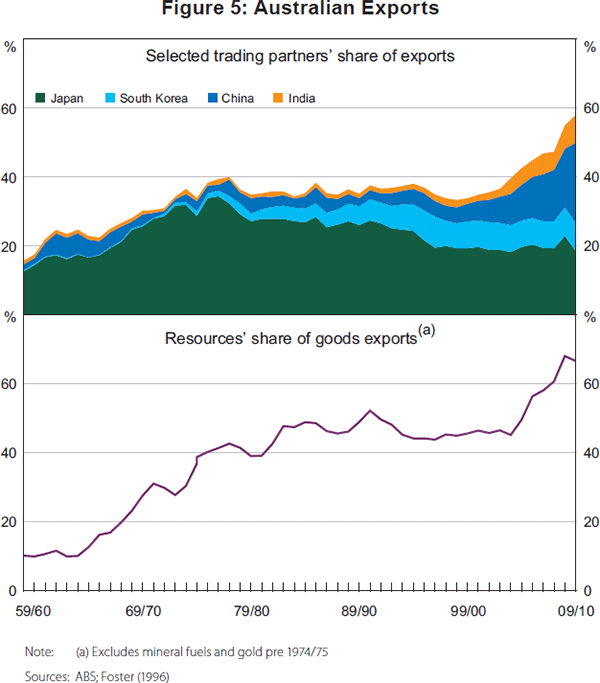
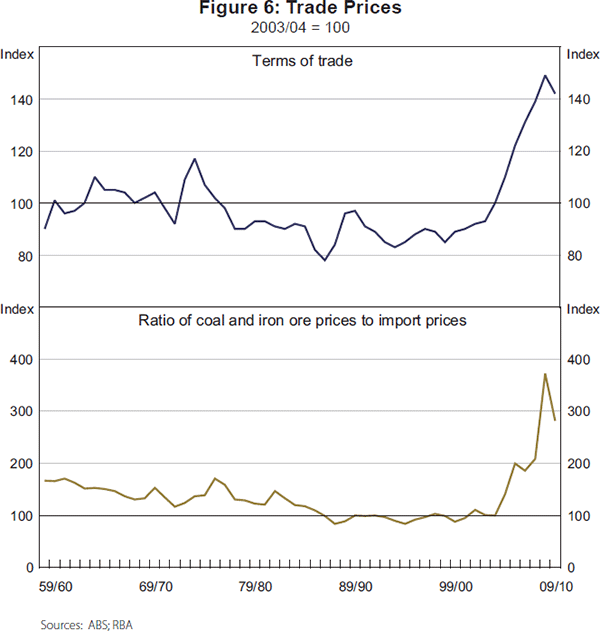
The difference in the price response is not simply because China is a larger country; at market exchange rates China's share of global GDP now is broadly similar to Japan's share in the mid 1970s. One key difference in the current episode is that China is experiencing much more resource-intensive growth compared with Japan in the 1960s. Indeed, Eslake (2011) shows that the share of global GDP produced by countries at a resource-intensive stage of development is currently much larger than at any time in the second half of the 1900s. China's share of global steel production has increased from 15 per cent at the start of the decade to around 45 per cent in 2010. In contrast, Japan's share of global steel production peaked at 17 per cent in 1973.[5] Similarly, at the end of the decade China accounted for close to half of global coal consumption, over 10 times Japan's share in the 1960s and 1970s.[6] Furthermore, Australia's resource export volumes also grew more rapidly in the 1960s and the first half of the 1970s, with annualised growth around 15 to 20 per cent, compared to 5 per cent over the past decade, seemingly reflecting the greater difficulties with expanding an already large and relatively mature mining industry.
4. Household Balance Sheets
At the start of the decade, households were facing favourable economic conditions. Steady growth in employment and wages was delivering rising incomes, while wealth was increasing with rapid growth in house prices and steady, if not spectacular, increases in domestic share prices. These factors gave households the confidence to reduce their saving. Further, household saving out of current income was reduced as households moved to a higher debt-to-income level because of their greater access to credit. The saving rate continued the decline that had commenced in the mid 1980s, and by early in the 2000s household spending (net of depreciation) was estimated to exceed household incomes (Figure 7).
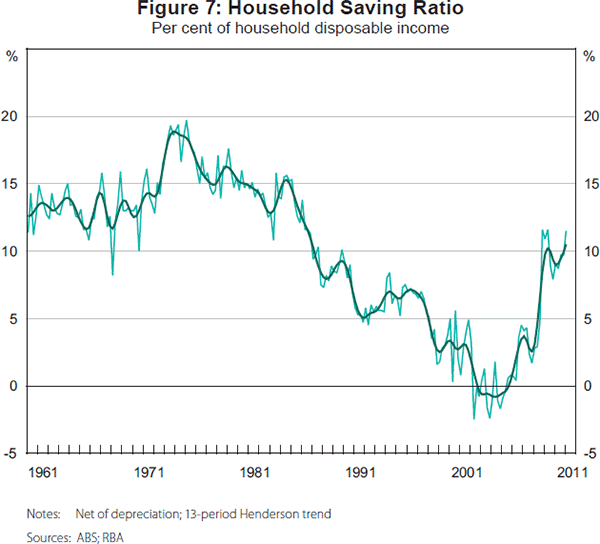
House prices had begun to rise from the mid 1990s reflecting a couple of key factors. First, the decline in nominal interest rates associated with lower inflation reduced the initial repayment burden for a given loan size and so increased households' borrowing capability. Second, the increased competition and innovation in the lending market that started with the reforms of the banking sector in the 1980s had greatly increased the accessibility and availability of housing finance (see Yates (this volume) and Ellis (2006)). In the late 1990s the rate of dwelling price growth accelerated and in the first four years of the 2000s prices increased at an average rate of 14 per cent.
Rising house prices were accompanied by accelerating growth in borrowing for housing. Growth in housing credit increased from rates around 12 per cent in the second half of the 1990s to over 20 per cent in 2003 (Davis, in this volume, summarises this and other financial developments over the decade). The sense that this was unsustainable was heightened by the increasing share of this borrowing undertaken by households buying properties to rent out rather than owner-occupy. As discussed in Bloxham et al (2010) and in Section 5, the dynamics of rapid house price and credit growth, in conjunction with some signs of excess in parts of the housing and lending markets, became an increasing concern for the Reserve Bank and other policy-makers. Partly in response to policy measures, national house prices plateaued in late 2003 and were broadly flat in nominal terms over the following two years. While there were some differing regional cycles, notably with falls in nominal prices in Sydney in 2004 and prices in Perth continuing to grow strongly, overall national house prices grew broadly in line with household incomes between 2003 and 2008, followed by a small fall in the national median house price in 2008 (Figure 8). Nevertheless, credit continued to grow at a brisk pace, not slowing to the 12 per cent rates of the late 1990s until late 2005. With growth in household borrowing outpacing that in incomes, the ratio of household liabilities to incomes continued to rise, as did the ratio of liabilities to assets.
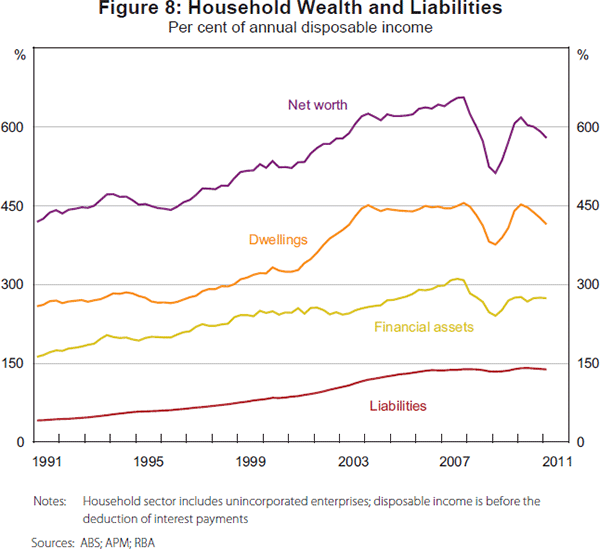
Financial asset holdings also increased over the decade. This masked differing trends, with superannuation assets as a ratio to income increasing strongly from around 110 per cent at the start of the decade to over 150 per cent (Figure 9). This reflected strong compulsory and voluntary flows into superannuation and the large share of superannuation invested in domestic equities, which experienced strong returns over the decade. In contrast, non-superannuation financial assets declined as a ratio to income so that by the end of the decade superannuation assets were larger than all other financial assets. The value of households' total financial assets peaked in late 2007 at over 300 per cent of income, but the subsequent falls in values during the financial crisis were larger than for housing and valuations and have yet to recover this previous peak.
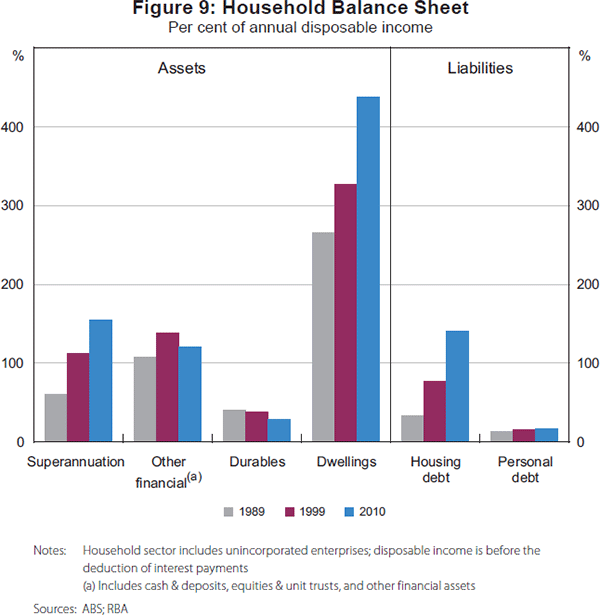
As discussed above, several factors contributed to the strong growth in house prices up to the mid 2000s, with a key one being the liberalisation of the credit market. Greater access to credit enabled households to substantially increase their borrowing over the 1990s and 2000s. The growth in household borrowing outpaced house price growth so that housing gearing increased from 11 per cent in 1990, to 21 per cent in 2000, to a little under 30 per cent in 2010. Once house prices and borrowing were rising together, it was difficult to determine whether increased borrowing capacity led to higher house prices or rising house prices spurred increased borrowing.
One benchmark is to compare Australian households' debt levels to that of other countries. In 1990 Australia had one of the lowest household debt-to-income ratios in the developed world at 46 per cent. By 2000 it had doubled to 94 per cent and was similar to that in Canada and the United States. By the end of the 2000s, the Australian ratio at around 150 per cent of household disposable income was one of the highest in a group of comparable developed economies (Battellino 2010).
Even with these higher levels of debt, loan arrears rates and defaults have remained low relative to history and other countries (RBA 2011). Further, most of the debt is held by higher income households who appear well placed to repay this debt (Battellino 2010). Nevertheless, as recent international experiences demonstrate, household debt can amplify shocks. As Stevens (2010b) notes, Australian households would be prudent not to increase their indebtedness at the same rate as over the past two decades.
5. Monetary and Financial Policy
5.1 The framework
The past decade saw less debate than in previous decades about the appropriate monetary policy framework for Australia. Throughout the 2000s, there was broad community and political support for the key elements of the framework which include: (i) a medium-term inflation target; (ii) the cash rate being the instrument of monetary policy; (iii) the Board of the RBA setting the cash rate independently of government; and (iv) the RBA being accountable for, and communicating, its decisions.
The main framework-related issue over the decade was the role of monetary policy in addressing financial imbalances. While this has recently been topical at the global level following the financial crisis, it was extensively discussed in Australia in the early years of the decade. Here, the particular issue was the extent to which the RBA should take account of the then rapid increases in housing credit and housing prices when setting the cash rate.
In 2001, even as the RBA was cutting interest rates as a result of the global slowdown in the aftermath of the tech boom, it was expressing concerns that lower interest rates risked further boosting housing prices and credit. Then in 2002 and 2003 as interest rates were being increased, the RBA frequently noted the risk of imbalances building up in the housing market. In 2003, in particular, the most common theme in speeches and in the RBA's research agenda was the risks posed by unsustainable growth in both housing credit and prices. In part, the RBA's strategy during this period was to bring to the public's attention the risks involved with making investment decisions on the assumption that the then current trends would continue.[7] Unlike every other developed country, and most large emerging economies, the RBA did not cut interest rates at any point in 2003.
During 2002 and 2003, the RBA came in for some criticism from those who saw it as exceeding its mandate or who interpreted its actions as targeting housing prices. The RBA went to considerable lengths to explain its actions as consistent with flexible inflation targeting and to explain that it was not targeting credit growth or asset prices. Developments in the housing market were, however, given as one reason for increasing interest rates in response to general macroeconomic conditions sooner rather than later.
Internationally, the debate on how monetary policy should respond to emerging financial imbalances is far from settled. The weight of opinion has, however, shifted somewhat towards the view that in some situations it may be appropriate to respond to a big run-up in assets prices that is accompanied by rapid credit expansion.[8] While this view can sit uncomfortably with a more rigid inflation-targeting framework where the policy rate is set so that the inflation forecast at a fixed horizon is equal to the target midpoint, it is not inconsistent with the medium-term inflation-targeting framework that the RBA has employed since 1993. In particular, in some situations, responding to financial imbalances may deliver an average inflation rate that is closer to the target and less volatile, even if it results in some short-run deviation from the target. This is particularly so if such a response can help avoid a costly ‘boom and bust’ that damages the financial system. The challenge here is how this can be done in practice. How might adjustments in interest rates be calibrated? What is the trade-off with other policy instruments? And, how are such actions best explained to the public? These questions are likely to be debated frequently over the decade ahead.
Looking back, it is difficult to judge how effective the RBA's approach was in the early 2000s. The Bank's comments at that time did, however, attract widespread media coverage, including in the popular press. Following the increase in interest rates at the end of 2003, housing price growth did decelerate sharply, and Australia was able to avoid the worst of the excesses seen in other housing markets around the world. Furthermore, the adjustment in housing prices was not accompanied by major stress in either the household or financial sectors.
Whatever conclusions one draws from that particular episode, the past decade has seen a shift globally towards a more flexible approach to inflation targeting. With the adoption of inflation targeting by some countries in the 1990s, there was a discussion about the importance of constraining the discretion of the central bank, so that it delivered on its inflation objective.[9] In a sense, this was understandable given the experience of earlier decades. But as inflation expectations became better anchored, a number of central banks have adopted a more flexible approach with greater consideration given to medium-term outcomes, including for output and employment. Recently it has also become clearer that low inflation does not guarantee financial stability and so there is increasing thought being given to how the setting of monetary policy should take into account financial stability issues.
A second framework-related issue that was at times controversial was the degree of transparency of the RBA's decisions. While in 1990 the RBA was one of the first central banks to commence releasing a statement announcing changes to the policy interest rate, for many years, the RBA was ambivalent about the practice of releasing statements and minutes after every Board meeting. The main concern was that too frequent communications would create additional uncertainty. But by 2007, the evaluation of the benefits and costs of increased communication had changed, partly based on the experience of other central banks. Since then, a statement has been released after each Board meeting and minutes have been released two weeks after the meeting.[10] In February 2008, the Bank also began publishing numerical forecasts for both inflation and output on a quarterly basis, after having published descriptive forecasts in the Statement on Monetary Policy for over a decade, and the amount of material published by the Bank, and the number of public speeches given by senior staff, has increased significantly. Unlike many other central banks, RBA officials take questions from the media at these speeches, although the RBA does not hold regular press conferences as have become increasingly common elsewhere.
One issue that attracts attention periodically is the structure of the RBA Board, which has a majority of part-time external members drawn primarily from the business community. This longstanding structure is unusual by international standards and has both its critics and defenders. Its critics raise the issues of conflicts of interest and the capability of part-time members to question the views being put by the RBA executives. In contrast, supporters of the current structure point to the importance of bringing timely, real-world experience to the RBA's deliberations and the generally successful outcomes delivered by the current arrangements. Over the decade the only change made to the appointment process was in 2007, when the Treasurer announced that new Board appointments would be made from a register of eminent candidates to be maintained by the Secretary to the Treasury and the Governor of the RBA.
The Statement on the Conduct of Monetary Policy, which records the common understanding of the Governor and the Government on key aspects of Australia's monetary policy framework, was re-signed four times during the decade.[11] On each occasion, the broad objectives of monetary policy and the key elements of the inflation target were reaffirmed. The largest change to the Statement was in 2010, when a separate section on financial stability was added, recognising the RBA's longstanding responsibilities in this area. The other main changes were made in 2007 and related to the RBA's independence and its increased transparency.
5.2 The major policy considerations
Apart from developments in the housing market, two major issues confronted monetary policy over the decade. The first was the very large shift in the relative price of commodities, which led to Australia's terms of trade rising to their highest level in over 140 years. The second was the North Atlantic financial crisis and the associated severe global recession.
Looking back over the past decade, the most frequently recurring theme in the RBA's communications was the rise in Australia's terms of trade. This rise has not only been very large, but it has taken place almost continuously since 2003, although there was a sharp, but temporary dip, during the financial crisis. It was largely unexpected and, in hindsight, is explained by the boom in China following a period of relatively low global investment in resource extraction and food production. Like many others, the RBA repeatedly revised up its forecasts for the level of commodity prices and the terms of trade over the period (Figure 10).
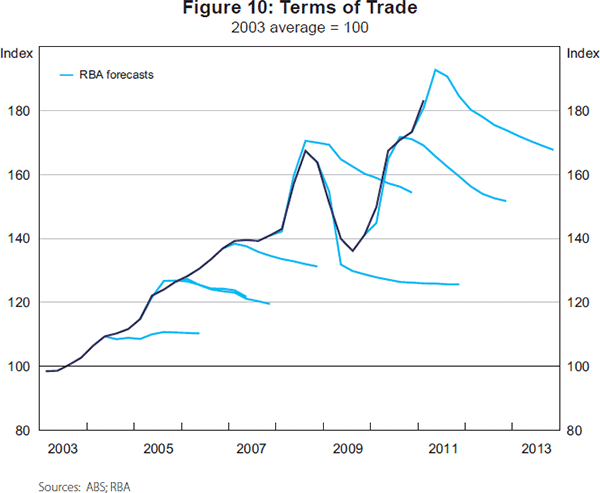
This rise in the terms of trade, and the frequent upside surprises, meant that for most of the decade monetary policy was being tightened. Indeed, from 2004 to 2008, the RBA's two-year-ahead forecast for inflation, based on the assumption of a constant cash rate, was in the top half of the medium-term target band. Not surprisingly, there was a long upswing in the cash rate running from 2002 to 2008, with monetary policy becoming restrictive in 2006 (Figure 11). The pace of tightening picked up in late 2007 as it became clear that capacity pressures in the economy were leading to a sharp pick-up in inflation. This pick-up was substantially larger than the RBA had been expecting and it saw underlying inflation increase to a little above 4½ per cent.[12]
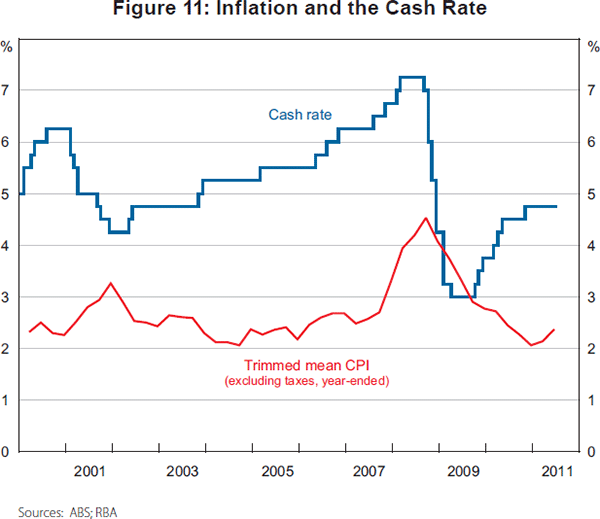
This peak in inflation occurred in the September quarter of 2008, just when the financial crisis was intensifying dramatically following the failure of Lehman Brothers. Despite the high inflation rate, the RBA cut the cash rate rapidly over the final months of 2008 as the global economic outlook deteriorated markedly. Including the 25 basis point cut in September, the cumulative reduction from the peak in the cash rate was 425 basis points to 3 per cent in April 2009, a new cyclical low but substantially above policy rates in almost all other developed economies.
Importantly, the RBA also provided significant liquidity support to the domestic money market. Unlike many other central banks it was able to do this through its pre-existing framework for market operations. This framework allowed significant flexibility as the RBA had long dealt with a wide range of counterparties, dealt in the market every day, and conducted repurchase agreements for a range of maturities and with different classes of collateral. Following the failure of Lehman Brothers, the RBA, among other actions, increased the supply of settlement balances to increase the liquidity of the system and widened the pool of securities eligible for repurchase agreements.[13] These actions helped smooth the operation of the financial system in what were very troubled times globally. Overall, the assistance that was provided was considerably less than in many other countries and was able to be unwound relatively quickly as conditions improved.
6. Fiscal Policy
One of the most striking differences between macroeconomic policy in Australia and that in most other developed economies is the way in which fiscal policy has been conducted over the past couple of decades.[14] In the 11 years to 2007/08, the Australian Government ran budget surpluses on 10 occasions, and by 2005/06, the Government had no net debt (Figure 12).[15] In contrast, most countries in the OECD have consistently run budget deficits, with the aggregate debt-to-GDP ratio showing little change over the two decades to 2007, before increasing sharply during the financial crisis (Figure 13).
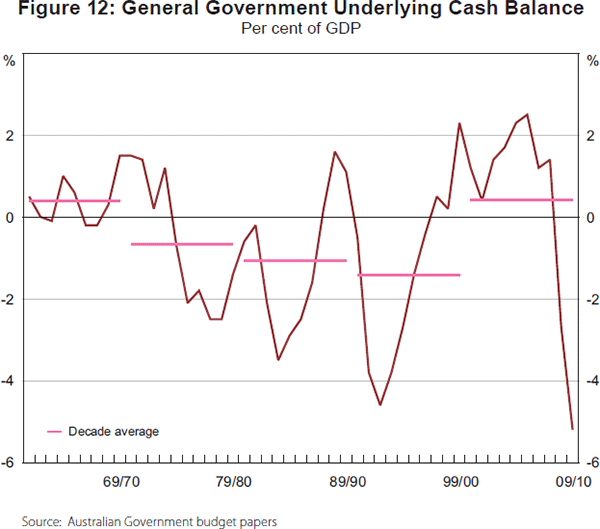
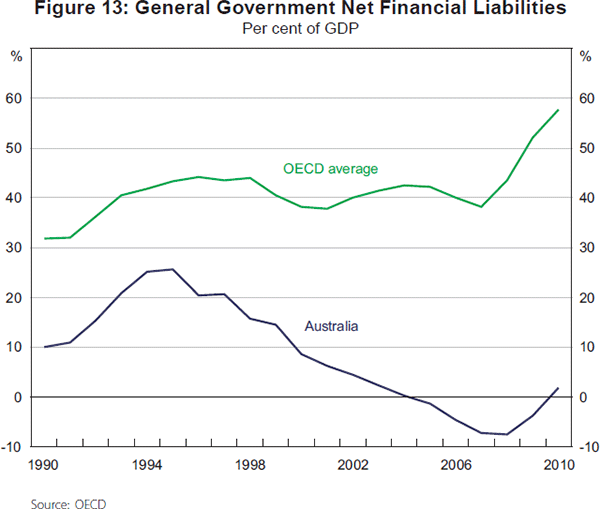
It is difficult to pinpoint the reasons why fiscal policy in Australia has been conducted so differently to that in many other countries. The strong terms of trade has certainly helped, although the commitment to sound fiscal policy predates, by quite a few years, the big run-up in the terms of trade. Perhaps its origins lie in the debates in the 1980s and early 1990s about the current account deficit. These debates were associated with a sense of national economic insecurity regarding the consequences of high and persistent trade deficits. In the national soul searching that went on at the time, an increase in public sector savings was widely regarded as the most effective way of ‘improving’ the current account deficit. This view coincided with some dissatisfaction with the effects of the stimulatory fiscal policy in the early 1990s.
In retrospect, it is somewhat ironic that when public savings did increase in the mid 1990s there was not a reduction in the average current account deficit. Yet the public commitment to sound fiscal policy that emerged during those years has been highly persistent. Both major political parties have committed to maintain a balanced budget over a run of years, and there is broad public support for this approach.
Against this backdrop, three fiscal issues have attracted considerable attention at various points over the decade: (i) the role that fiscal policy can play as a countercyclical tool; (ii) the appropriate use of the revenue from the resources boom; and (iii) the role of public debt in financing public sector infrastructure.
For some years up until the crisis, the conventional wisdom was that fiscal policy's role as a countercyclical tool was limited to allowing the automatic stabilisers to work. Using discretionary fiscal policy was seen as too difficult from both a political and implementation perspective. The financial crisis in 2008 changed this, with many countries implementing large fiscal stimuli, under the imprimatur of the IMF and the G-20. The stimulus in Australia – equivalent to around 6 per cent of GDP – was one of the largest in the world. It was also the largest discretionary easing of fiscal policy in at least two decades.
One reason that Australia was able to implement such a large stimulus was that public finances were in sound shape prior to the crisis; unlike in many other countries, the fiscal response was not constrained by concerns about medium-term fiscal sustainability. Whether this episode marks a return to more activist fiscal policy though remains to be seen. In many respects the circumstances that led to the stimulus were highly unusual: a crisis in the global financial system, a very large increase in uncertainty and risk aversion, and a collapse in international trade. These events were easily identified and were not the result of domestic factors, thus overcoming some of the hurdles that can limit the fiscal response to a deterioration in economic activity.
A second issue has been how the proceeds of the resources boom should be used. In the period from 2004 to 2008, the strong growth in nominal income generated strong growth in tax receipts. This growth in revenue was used to fund significant cuts in income tax and increase transfer payments to the household sector, as well as to build up assets in a number of funds. While estimates of the structural budget position during this period are very sensitive to assumptions about the ongoing level of the terms of trade, most estimates suggest a deterioration during the latter part of this period, although the actual surplus remained around 1½ per cent of GDP.
During this period there was some debate as to whether the fiscal proceeds from the strong economy should have been used in other ways. A similar debate has resurfaced over the past year or so when considering how the proceeds of the current resources boom should be dealt with if the boom continues. One perspective has been that some of the proceeds should be allowed to accumulate in a fund to support future spending. The argument here is that, given the uncertainty about the longevity of the resources boom, it might be prudent to increase public-sector saving to smooth public expenditure and support the economy if the boom were to unexpectedly end.[16] A related argument is that saving the proceeds could take some of the pressure off aggregate demand. On the other hand, one counterargument is the boom is expected to be highly persistent and thus accumulating revenue in a fund would be an inappropriate transfer from current taxpayers to future taxpayers. Another argument has been that using growth in revenue to fund tax cuts would help improve the incentives for work and promote growth in the economy.
A third issue has been the role of the public sector in infrastructure provision. From the mid 1980s until around the mid 2000s there was a steady decline in public investment relative to GDP, largely due to declining investment by state governments. A number of these governments have limited the borrowing that they have been prepared to undertake for public infrastructure, partly due to concerns that increased borrowing could jeopardise their high credit ratings. While this approach has ensured that state government finances have remained generally sound, its critics argue that it has led to projects not being undertaken that have social rates of return considerably higher than the cost of borrowing.[17] The aversion to debt also saw strong growth in public-private partnerships as a way of funding infrastructure, with mixed results. An issue over the coming decade is likely to be how to fund public-sector infrastructure and the appropriate size of public-sector balance sheets.
7. Making the Best of the Terms of Trade Boom and Managing the Risks
As discussed above, the Australian economy has performed strongly over the past two decades and has avoided a severe downturn. From some perspectives though, the economy looks to have moved out along the risk-return frontier, particularly over the latter part of this period. Australia's abundant supply of natural resources and its strong links with Asia have significantly boosted real incomes and have substantially improved the expected outcomes over the next decade. But along with the new opportunities and higher expected returns have come new risks.
During the 2000s, Australia's international trade became more concentrated, both in terms of the goods exported and export destinations, potentially exposing the Australian economy to larger shocks. Over the past year, for example, exports of metal ores and coal have accounted for around 40 per cent of Australia's total export receipts, and exports to Asia now constitute more than 60 per cent of Australia's total exports, with Japan and China accounting for two-thirds of that. Further, an increasing share of exports is to emerging economies, which historically have had more volatile economic growth.
Looking forward, the challenge is to ensure that Australia makes the best of the new global economic landscape while at the same time managing the risks that come with this landscape.
In taking advantage of the new opportunities, the economy is inevitably undergoing significant structural change. The return on capital is high in the resources and related sectors, and labour and capital are flowing to these sectors. At the same time, other sectors are contracting in relative importance. These adjustments can be very difficult for those involved, including the owners of the existing capital in the industries not growing strongly and those working in these industries. But the economy made similar adjustments in previous decades, and if these adjustments do not occur then Australia is likely to forego some of the expected benefits that the strong growth in Asia offers.
In addition, for these benefits to be fully realised, productivity growth will need to pick up. In the 1990s, strong growth in living standards was underpinned by strong growth in output per hour worked. However, productivity growth slowed significantly in the 2000s, with output growth being boosted by faster growth in capital and labour, and income growth being boosted by the rise in the terms of trade (Figure 14).
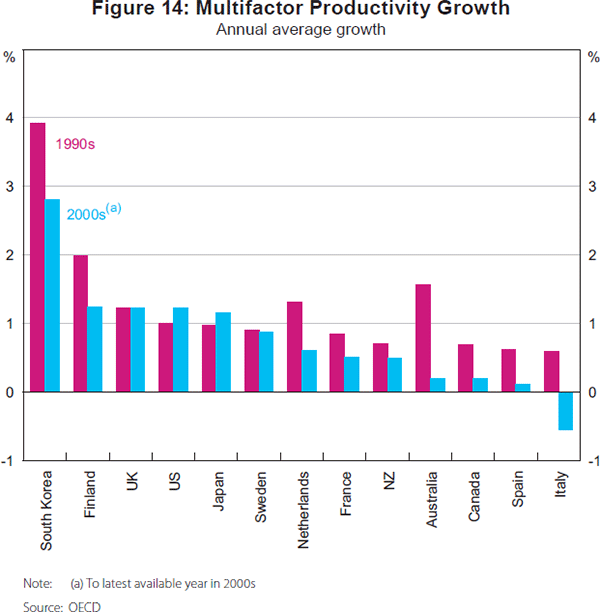
In the decade ahead, it is highly unlikely that the rise in the terms of trade witnessed in the 2000s will be repeated. This means that if living standards are to continue to rise at the rate we have become accustomed to, productivity growth will need to pick up significantly. For Australia to fully capitalise on the new possibilities, both businesses and government need to be focused on improving how things are done and addressing inefficiencies in regulation and business practices. If this does not occur and complacency bred by good economic times was to set in, then some of the benefits that now seem possible would fail to materialise.
A related set of challenges is how to ensure that the Australian workforce has the appropriate set of skills to take advantage of the new opportunities. There also needs to be sufficient and appropriate infrastructure, with a suitable balance found between financing public-sector infrastructure and retaining sound public-sector balance sheets. In the period ahead, the economy will also need to continue its adjustment to more traditional savings patterns by the household sector after a protracted period in which growth in consumption exceeded that in income. In addition, as an economy with a comparative advantage in the production of carbon-based energy, Australia faces a challenge as the world looks to less carbon-intensive forms of energy.
In terms of the risks, there is little that Australia can do to reduce the probability of economic volatility elsewhere in the world. But the choices that are made domestically can have a significant effect on how such volatility affects the Australian economy.
The floating exchange rate remains a key stabilising influence. Over the past three decades, movements in the value of the Australian dollar have played an important role in offsetting some of the effects of large shocks from the global economy (Debelle and Plumb 2006). While these movements can have significant implications for individual businesses, for the overall economy they have been a source of stability.
Retaining flexibility in other areas is also a significant form of risk mitigation. One area that is important is the labour market. During the 2008–2009 downturn, flexibility in working arrangements and hours meant that the downturn in labour demand was spread more evenly across the workforce than would have occurred with less flexible arrangements. This spread the burden of adjustment and, arguably, helped avoid a more serious downturn in the economy.
The ability to respond quickly and decisively with macroeconomic policy is also important from a risk management perspective. Ensuring that the monetary policy framework remains credible is obviously important here. And in terms of fiscal policy, there is a need to ensure that public debt levels remain relatively low and that the medium-term fiscal outlook is seen as credible, and that fiscal policy is sufficiently flexible to be able to respond and be adjusted quickly.
More broadly, one form of possible risk mitigation is for the nation to save a significant share of the benefits of the resources boom, and then to only gradually increase spending if the outcomes are as positive as expected. Whether this is desirable though depends, in part, on society's tolerance of bearing risk. The benefit of higher savings is that if things do not work out as expected, costly adjustments might be avoided, or at least mitigated. Of course, the downside is that if things do work out well, current levels of national consumption are lower than desirable, with future consumption increasing strongly not only because of the favourable economic outcomes, but also because of the saving that is done now.
Another way in which risk is moderated is through foreign ownership in the mining sector. With a larger mining sector, growth in output and employment, and tax revenue, are more correlated with resource prices and demand than they have been in the past. Foreign ownership of the mining sector, however, means domestic investors hold more non-mining assets, including foreign assets, and so their investment income is less correlated with resources and the associated spillovers to the economy. Indeed, foreign ownership of this sector is estimated to be much higher than for the corporate sector as a whole. While this reduces the already substantial benefits to domestic residents of a mining boom, it also reduces the domestic costs of a mining downturn.
Overall, the 2000s were another prosperous decade for Australia. Strong employment growth contributed to a sustained fall in the unemployment rate and, along with a substantial increase in the capital stock, to faster growth in output than in most other developed economies. Over the latter part of the decade, the unprecedented increase in the terms of trade significantly boosted domestic income growth. To a considerable extent, the ability of the economy to prosper in this environment and avoid the overheating seen in previous booms in the terms of trade reflects the benefits of the flexible economic framework put in place over the past few decades and sound macroeconomic management over this period. The slowdown in productivity growth, after the pick-up in the 1990s, however, raises some troubling questions. While it is far from certain why productivity growth declined, what is clear is that for standards of living to continue to increase as they have in recent decades, faster productivity growth will be needed. Overall though, there remains much to be optimistic about. The Australian economy has demonstrated resilience and adaptability over the 2000s, and no doubt these characteristics will need to be on display once again over the coming decade.
Footnotes
Thanks to Michael Robson and many colleagues at the Reserve Bank for assistance and helpful comments. The views expressed are those of the authors and do not necessarily reflect the views of the Reserve Bank of Australia. [*]
This change in fortunes is highlighted in a comparison of The Economist (2000) which summarises the argument at the time that Australia was an ‘old economy’ and Grimond (2011) which highlights Australia's recent success. [1]
Commodity prices have increased further since then, so that the average value of the commodity price index in the first half of 2011 was four times that in 1999. [2]
See Kearns (2011) for a discussion of the roles of policy and external demand in the performance of the Australian economy in 2008–2009 in the context of a comparison with Canada. [3]
The target of inflation averaging between 2 and 3 per cent over the cycle is sometimes misinterpreted to imply inflation should average this midpoint of 2.5 per cent. For an early expression of the target equating to inflation averaging ‘two-point-something’, see Debelle and Stevens (1995). [4]
World Steel Association (2010). [5]
BP (2010). [6]
See Bloxham et al (2010) for a fuller discussion of the RBA's approach during this period as well as actions taken by APRA and ASIC. [7]
See Cagliarini, Kent and Stevens (2010) and Miskhin (2011) for more details. [8]
There was also a discussion on the need for ‘penalties’ on the central bank if the inflation target was not met. [9]
See Stevens (2007) for a full discussion of the reasons for this change. [10]
These re-signings occurred in 2003 following the reappointment of Ian Macfarlane as Governor, in 2007 when Glenn Stevens was appointed Governor, and in 2007 and 2010 following federal elections. [11]
See Lowe (2011) for a detailed account of this pick-up in inflation. [12]
See RBA (2009) and Debelle (2010) for more details. [13]
For a review see Gruen and Sayegh (2005). [14]
The decline in government debt in part also reflected asset sales. [15]
See, for example, Garnaut (2005) and OECD (2010). [16]
See, for example, Quiggin (2002), Argy (2007) and Gruen (2010). [17]
References
Argy F (2007), ‘Australia's Fiscal Straightjacket: Eight Myths about Tax and Public Debt Which are Holding Us Back’, Centre for Policy Development Occasional Paper No 4.
Battellino R (2010), ‘Aspects of Australia's Finances’, Address to Financial Executives International of Australia, Sydney, 15 June.
Bloxham P, C Kent and M Robson (2010), ‘Asset Prices, Credit Growth, Monetary and Other Policies: An Australian Case Study’, RBA Research Discussion Paper No 2010-06.
BP (2010), ‘Statistical Review of World Energy 2010’. Available at <http://www.bp.com/liveassets/bp_internet/globalbp/globalbp_uk_english/reports_and_publications/ statistical_energy_review_2008/STAGING/local_assets/2010_downloads/statistical_review_of_world_energy_full_report_2010.pdf>.
Cagliarini A, C Kent and G Stevens (2010), ‘Fifty Years of Monetary Policy: What Have We Learned?’, in C Kent and M Robson (eds), Reserve Bank of Australia 50th Anniversary Symposium, Proceedings of a Conference, Reserve Bank of Australia, Sydney, pp 9–37.
Debelle G (2010), ‘The Evolving Financial Situation’, Address to the Women in Finance Lunch, Sydney, 16 February.
Debelle G (2011), ‘In Defence of Current Account Deficits’, Address to ADBI/UniSA Workshop ‘Growth and Integration in Asia’, Adelaide, 8 July.
Debelle G and M Plumb (2006), ‘The Evolution of Exchange Rate Policy and Capital Controls in Australia’, Asian Economic Papers, 5(2), pp 7–29.
Debelle G and G Stevens (1995), ‘Monetary Policy Goals for Inflation in Australia’, RBA Research Discussion Paper No 9503.
Disdier A-C and K Head (2008), ‘The Puzzling Persistence of the Distance Effect on Bilateral Trade’, The Review of Economics and Statistics, 90(1), pp 37–48.
Economist, The (2000), ‘Something Old, Something New’, The Economist, 9 September, A Survey of Australia, pp 7–8. Available at <http://www.economist.com/node/359651?story_id=E1_PVJGVT>.
Ellis L (2006), ‘Housing and Housing Finance: The View from Australia and Beyond’, RBA Research Discussion Paper No 2006-12.
Eslake S (2011), ‘Commodity Prices’, Paper presented at the International Conference of Commercial Bank Economists, Amsterdam, 23 June.
Foster R (1996), ‘Australian Economic Statistics 1949–50 to 1994–95’, RBA Occasional Paper No 8, rev 1997.
Garnaut R (2005), ‘Is Macroeconomics Dead? Monetary and Fiscal Policy in Historical Context’, Oxford Review of Economic Policy, 21(4), pp 524–531.
Grimond J (2011), ‘No Worries?’, The Economist, 28 May, Special Report, pp 3–5. Available at <http://www.economist.com/node/18719530>.
Gruen D and A Sayegh (2005), ‘The Evolution of Fiscal Policy in Australia’, Oxford Review of Economic Policy, 21(4), pp 618–635.
Gruen D and S Shrestha (eds) (2000), The Australian Economy in the 1990s, Proceedings of a Conference, Reserve Bank of Australia, Sydney.
Gruen D and G Stevens (2000), ‘Australian Macroeconomic Performance and Policies in the 1990s’, in D Gruen and S Shrestha (eds), The Australian Economy in the 1990s, Proceedings of a Conference, Reserve Bank of Australia, Sydney, pp 32–72.
Gruen N (2010), ‘Paying for Australia's Infrastructure Deficit’, Inside Story, 23 November. Available at <http://inside.org.au/paying-for-australias-infrastructure-deficit/>.
Guttmann S and A Richards (2006), ‘Trade Openness: An Australian Perspective’, Australian Economic Papers, 45(3), pp 188–203.
Hall G and K Hooper (2008), ‘Australia's Exports of Education Service’, RBA Bulletin, June, pp 12–17.
Kearns J (2011), ‘Lessons from the Financial Crisis: An Australian Perspective’, Paper presented to the Central Banks Conference ‘Lessons from the World Financial Crisis’, Jerusalem, 30 March–1 April.
Lowe P (2011), ‘Inflation: The Recent Past and Future’, Address to the BankSA ‘Trends’ Business Luncheon, Adelaide, 24 June.
Miskhin F (2011), ‘How Should Central Banks Respond to Asset-Price Bubbles? The “Lean” versus “Clean” Debate After the GFC’, RBA Bulletin, June, pp 59–69.
OECD (Organisation for Economic Co-operation and Development) (2010), OECD Economic Surveys: Australia 2010, OECD Publishing, Paris.
Quah D (2011), ‘The Global Economy's Shifting Centre of Gravity’, Global Policy, 2(1), pp 3–9.
Quiggin J (2002), ‘Private Financing of Public Infrastructure’, Dissent, 8, pp 13–17.
RBA (Reserve Bank of Australia) (2009), ‘Operations in Financial Markets’, Annual Report 2009, pp 15–28.
RBA (2011), ‘Household and Business Balance Sheets’, Financial Stability Review, March, pp 43–54.
Stevens G (2007), ‘Central Bank Communication’, RBA Bulletin, December, pp 13–20.
Stevens G (2010a), ‘Monetary Policy and the Regions’, Address to Foodbowl Unlimited Forum Business Lunch, Shepparton, 20 September.
Stevens G (2010b), ‘Recent Developments’, Address to Western Sydney Business Connection, Sydney, 9 June.
Stevens G (2011), ‘Economic Conditions and Prospects’, Address to the Economic Society of Australia (Queensland) 2011 Business Luncheon, Brisbane, 15 June.
Tease W (1990), ‘The Balance of Payments’, in S Grenville (ed), The Australian Macro-Economy in the 1980s, Proceedings of a Conference, Reserve Bank of Australia, Sydney, pp 159–209.
World Steel Association (2010), Steel Statistical Yearbook 2009, World Steel Association, Brussels.